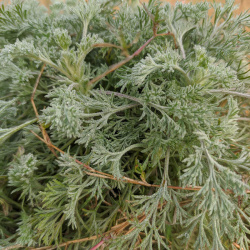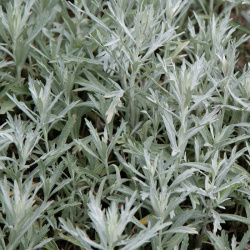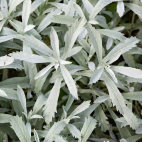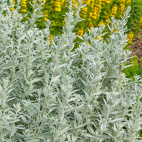Fringed Sage Seeds
Artemisia frigida
- HOW TO GROW
- FAST FACTS
HOW TO GROW
Sowing: In late fall or early spring, direct sow the seed on the surface of loose soil; thin or transplant seedlings. To start the seed indoors, sow it on the surface of a flat; keep the soil lightly moist and at a temperature of 65-70 degrees F until germination, which should occur within 10-14 days. As soon as the plants grow big enough to handle safely, transplant them.
Growing: This plant grows best in dry soil and full sun. It tolerates drought very well, and does not need watering. Excess moisture can cause root rot, and high humidity may damage the plant's growth. The plant may be lightly pruned to tidy its growth, but do not prune in the fall. The foliage will remain green throughout the winter in warm regions. This plant produces an abundance of seeds, reseeding itself easily if left to drop its seeds. Mature plants can be divided after several years of growth. This plant makes an excellent ground cover, and helps control erosion; deer and rabbits avoid it.
Harvesting: As soon as the plant grows to its mature height, stems can be harvested for fresh use or drying.
Seed Saving: When the flowers ripen into seed heads, watch them carefully to determine when the small seeds mature to a dark color. Strip the seed pods from the stem as soon as they fully ripen. Spread them out to dry, then thresh them carefully, taking care not to lose the tiny seed. Store the seed in a cool, dry place.
FAST FACTS
Common Names: Silky Wormwood, Fringed Sagebrush, Fringed Sagewort, Pasture Sage, Prairie Sage, Prairie Sagewort, Fringed Wormwood, Sweet Sage, Northern Wormwood
Latin Name: Artemisia frigida
Species Origin: US Native Wildflower
Type: Native Wildflowers
Life Cycle: Perennial
USDA Zones: 1, 2, 3, 4, 5, 6, 7, 8, 9
US Regions: Mountain, Arid/Desert, Plains/Texas, Midwest, Northern, Northeast
Seeds per Ounce: 225,000
Stratification: No Stratification
Germination Ease: No Stratification
Sunlight: Full Sun
Height: 12 Inches
Color: Yellow
Bloom Season: Blooms Late Summer
DESCRIPTION

HOW TO GROW
Sowing: In late fall or early spring, direct sow the seed on the surface of loose soil; thin or transplant seedlings. To start the seed indoors, sow it on the surface of a flat; keep the soil lightly moist and at a temperature of 65-70 degrees F until germination, which should occur within 10-14 days. As soon as the plants grow big enough to handle safely, transplant them.
Growing: This plant grows best in dry soil and full sun. It tolerates drought very well, and does not need watering. Excess moisture can cause root rot, and high humidity may damage the plant's growth. The plant may be lightly pruned to tidy its growth, but do not prune in the fall. The foliage will remain green throughout the winter in warm regions. This plant produces an abundance of seeds, reseeding itself easily if left to drop its seeds. Mature plants can be divided after several years of growth. This plant makes an excellent ground cover, and helps control erosion; deer and rabbits avoid it.
Harvesting: As soon as the plant grows to its mature height, stems can be harvested for fresh use or drying.
Seed Saving: When the flowers ripen into seed heads, watch them carefully to determine when the small seeds mature to a dark color. Strip the seed pods from the stem as soon as they fully ripen. Spread them out to dry, then thresh them carefully, taking care not to lose the tiny seed. Store the seed in a cool, dry place.
FAST FACTS
Common Names: Silky Wormwood, Fringed Sagebrush, Fringed Sagewort, Pasture Sage, Prairie Sage, Prairie Sagewort, Fringed Wormwood, Sweet Sage, Northern Wormwood
Latin Name: Artemisia frigida
Species Origin: US Native Wildflower
Type: Native Wildflowers
Life Cycle: Perennial
USDA Zones: 1, 2, 3, 4, 5, 6, 7, 8, 9
US Regions: Mountain, Arid/Desert, Plains/Texas, Midwest, Northern, Northeast
Seeds per Ounce: 225,000
Stratification: No Stratification
Germination Ease: No Stratification
Sunlight: Full Sun
Height: 12 Inches
Color: Yellow
Bloom Season: Blooms Late Summer
Also Consider These:
-
 Beach Wormwood Seeds
Artemisia caudata
Quick View
x
Beach Wormwood Seeds
Artemisia caudata
Quick View
xBeach Wormwood Seeds
Starting at $3.48 USD -
 On Sale!
Prairie Sage Seeds
Artemisia ludoviciana
Quick View
x
On Sale!
Prairie Sage Seeds
Artemisia ludoviciana
Quick View
xPrairie Sage Seeds
Starting at $3.75 USD










